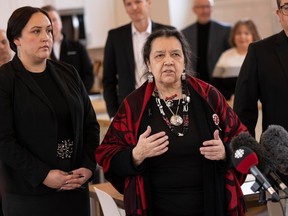Language Nest — ta tsíptspi7lhḵn — is now a ‘home’ to a dozen families and 18 babies

Article content
Syexwáliya picked up a few words of Squamish as a girl from her grandfather, but was forbidden from speaking it out loud lest she be beaten, as her mother and grandmothers had been for speaking their native language.
So to step inside a new language immersion school on Squamish Nation for the first time was a moment of joy.
Article content
The Language Nest — Ta Tsíptspi7lhḵn in Sḵwx̱wú7mesh, the Squamish language — will be the first time the language program for babies and toddlers will have its own dedicated space. The program began in 2019 in shared space with Capilano Little Ones.
Advertisement 2
Article content
“Yewanha7ilh skwalwen,” Syexwáliya, also known as Ann Whonnock, said, “yewanha7lh skwalwen.”
It means excellent heart and mind, and she can’t wait for Squamish Nation’s little ones to become the first in a couple of generations whose mother tongue will be Squamish.
“I learned words from my grandfather, and what he was teaching me about how we are supposed to be as people,” Whonnock said. “But I am not fluent because of what the residential schools did to my grandmother and my mother.”
The language school’s philosophy is to create an immersion setting in a homelike environment for babies and their families. Since Sḵwx̱wú7mesh was historically an oral language without a formal writing system, a writing developed over the years, and the current system was adopted officially in 1990.
Whonnock spoke a word that she said means standing and working together, holding each other up, and how her grandfather explained to her how hard the word was to translate, and that language and culture are intertwined.
Her grandfather was Dominic Charlie, a chief of the Squamish people in the 1950s who was born in the village of Sen̓áḵw on Jericho Beach, and named after his father Jericho Charlie. Chief Charlie’s half-brother was Chief August Jack Khatsahlano, after whom Kitsilano was named.
Article content
Advertisement 3
Article content
The building is a 112-year-old former Kits landmark known as the little yellow school house, which was barged across Burrard Inlet to the North Shore before undergoing six months of renovations to officially open on Friday as the language program’s first dedicated home.

The Squamish people were barged across Burrard Inlet, too, and sent to the North Shore around the time the school house was built, so Vancouver could expand.
Wakaystn Campbell, who turns two this weekend, was unaware of any symbolism. He was busy having a fabulous time exploring the new language nest, playing with toy fish in a raised pond and singing Sḵwx̱wú7mesh nursery rhymes with his teachers.
Fifteen years ago, only 10 Sḵwx̱wú7mesh speakers remained, but there are currently 12 families with 18 babies such as Wakaystn in the program and the number of Sḵwx̱wú7mesh speakers now numbers more than 100.
“This building was moved from a place where people had an immense love for the building and the work that it did since 1912,” said Samaya Jardey, director of the Language Nest.
“For a little bit of a different reason we, too, are so grateful to receive it on this side, to having it moved from the village of Sen̓áḵw to have it come to Sḵwx̱wú7mesh Úxwumixw.
Advertisement 4
Article content
“In a way it made its choice to be here, to be a part of the land and the language.”
Recommended from Editorial
Bookmark our website and support our journalism: Don’t miss the news you need to know — add VancouverSun.com and TheProvince.com to your bookmarks and sign up for our newsletters here.
You can also support our journalism by becoming a digital subscriber: For just $14 a month, you can get unlimited access to The Vancouver Sun, The Province, National Post and 13 other Canadian news sites. Support us by subscribing today: The Vancouver Sun | The Province.
Article content





